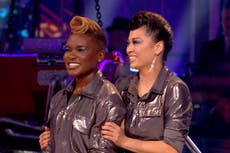In praise of Claudia Winkleman, the woman who taught Strictly to laugh at itself
When Bruce Forsyth left ‘Strictly’ in 2014, many questioned how the show would go on. But as Tess Daly’s new co-host, Claudia Winkleman brought with her a self-aware sarcasm that allowed the show to become cool for the first time, writes Isobel Lewis


Few presenters make a statement quite like Claudia Winkleman, with her smudged black eyeliner, dangerously long fringe and perma-tanned complexion. Since taking over as co-host of Strictly Come Dancing in 2014, Winkleman has brought an edge to the show that wasn’t previously there, transforming it to something – dare I say – cool.
I pause when using that word to describe Strictly, because when the show first began in 2004, the possibility that it could ever be considered cool seemed laughable. But over the years Strictly has gained a sense of self-awareness and learnt to lean into its camp silliness, in a change that stems from Winkleman taking over as co-host from Bruce Forsyth in 2014.
The much-loved Forsyth shaped the first 10 seasons of Strictly tonally. With his catchphrases and occasional dances, it felt like a classic entertainment programme. When he left in 2014, many questioned how the show would go on. But Forsyth’s departure marked a new era, with co-host Tess Daly stepping into his tap shoes and Winkleman into Daly’s stilettos: not better, but different. After 11 series, Strictly was changing for the first time – which was necessary for it to survive.
Ballroom dancing has always had a reputation for being a bit old-fashioned, and sticking “Strictly” onto the name – a reference to Baz Luhrmann’s 1992 film Strictly Ballroom – had never been enough to detract from that. While ex-EastEnders stars were learning to waltz over on the BBC, ITV’s latest series The X Factor was giving the public exactly what they wanted. Sob stories! Drama! Public humiliation! No matter how much Arlene Phillips spoke about “sex appeal”, Strictly still felt grandparent-friendly and slightly embarrassing to admit to watching.
The introduction of Winkleman was a sign that Strictly could do things differently without losing what it was centrally about. Both in terms of aesthetic and presenting styles, Daly and Winkleman seemed on paper to be at odds with each other, but the pair came to represent the classic (ballroom dancing) and modern (reality TV) coming together. It was something Strictly had long been doing in content – contestants are just as likely to perform to a Frank Sinatra song as a current chart hit – but struggled to recreate in tone.
When you watch Strictly, there’s never a sense that the presenters are stepping on each other’s toes; Daly is the straight-man ringmaster responsible for getting people where they need to go, while Winkleman runs the expertly nicknamed “Claud-itorium”. Overlooking the dance floor, the latter area has become a safe haven where the contestants come post-dance, a place where they can shed a tear after grinning through devastating criticism from Craig Revel Horwood or collapse on the floor at their first 10.
That vibe is engineered by Winkleman herself, who peppers her chats with knowing looks, sarcastic comments and the occasional glimpse of actual fear shared with the camera crew when something goes wrong. It’s the one part of the show that doesn’t feel expertly engineered to facilitate maximum audience enjoyment – it’s more like watching an intimate conversation between colleagues. In this space, the contestants are able to take a step back from the sincerity of the dancefloor, look at the costumes they’re wearing or songs they’re dancing to, and revel in the glorious ridiculousness of the whole thing.
In bringing a sarcasm that acknowledges Strictly’s campness, Winkleman revitalised the show’s tone and image. Strictly isn’t a dance version of The X Factor or a modern take on Come Dancing and never has been. It’s closer to Eurovision, with Winkleman playing the role of the British public; the shirts are dangerously low-cut, the music is ridiculous but we love to watch it as much as we love to laugh at it. We’re told (and inevitably never believe) while growing up that there’s nothing cooler than being who you are. Now in its mid-teens, Strictly has finally learnt that.
Join our commenting forum
Join thought-provoking conversations, follow other Independent readers and see their replies
Comments


Bookmark popover
Removed from bookmarks